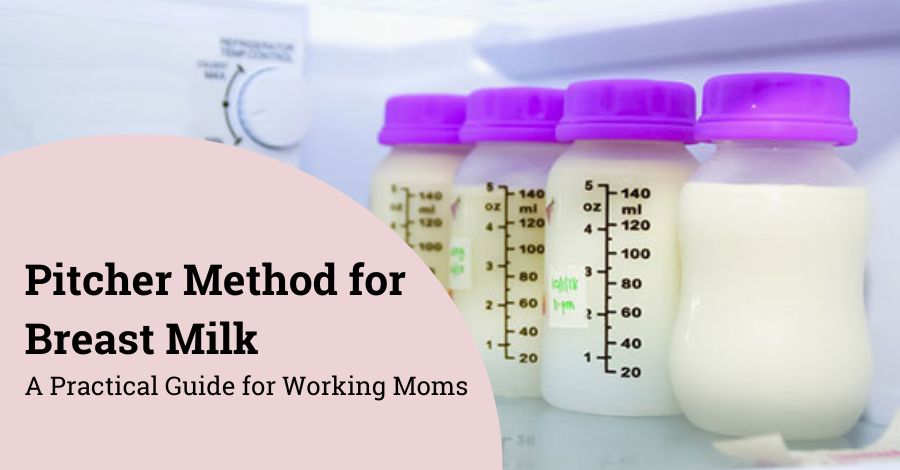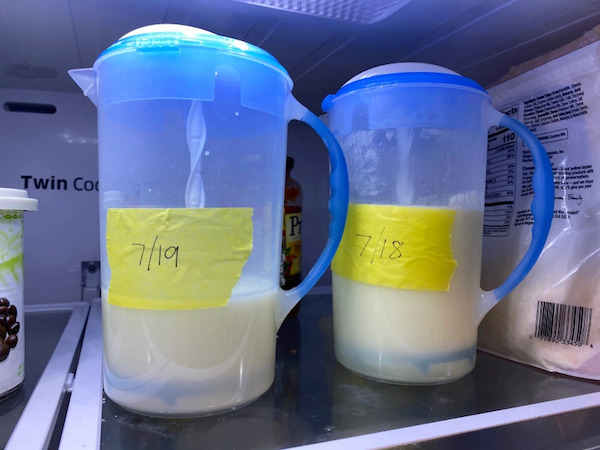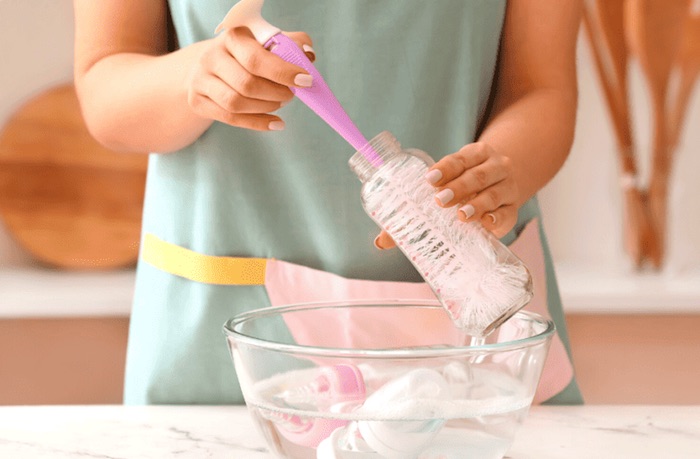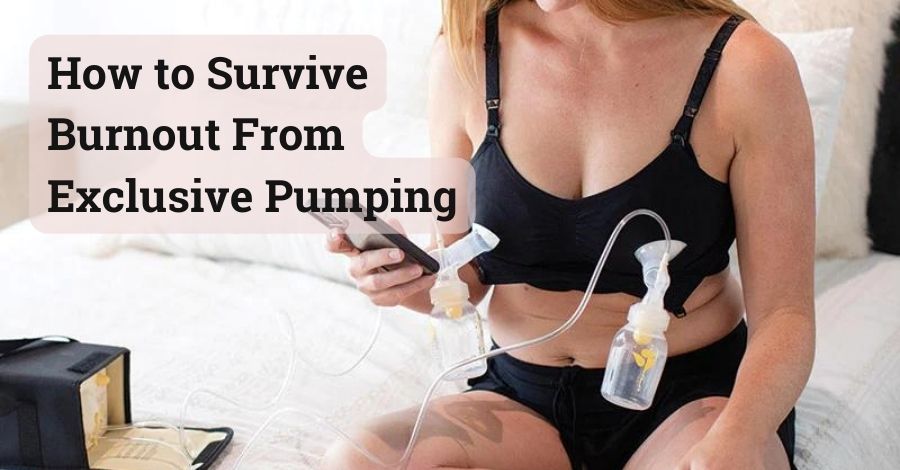Juggling work and motherhood? The pitcher method turns breast milk storage into a stress-free task!

Key Points
- The pitcher method breast milk simplifies breast milk storage by collecting all pumped milk into one container.
- It’s time-saving and convenient for busy moms, reducing the need for multiple bottles and cleaning.
- Safety is important—keep the milk refrigerated and cool fresh milk before mixing.
- It’s an efficient system for working moms to manage their milk supply.
- Use the FIFO method by labeling and using the oldest milk first to prevent waste
Going back to work as a mom while trying to keep breastfeeding can be really challenging. Balancing your professional life with your baby’s needs requires efficient strategies, especially when it comes to pumping and storing breast milk. One approach that has gained popularity among nursing mothers is the pitcher method breast milk. This method simplifies the collection, storage, and preparation of breast milk, making it a great choice for busy working moms. In this article, we will take a closer look at the pitcher method, its advantages, safety guidelines, and practical tips to make it work for you.
What Is the Pitcher Method?
The pitcher method involves collecting breast milk from multiple pumping sessions into one large container, usually a pitcher. Instead of storing milk in numerous small bags or bottles, you pour all your pumped milk into the pitcher throughout the day. At the end of the day or before feeding, you can pour the needed amount into individual bottles for feeding or freezing.
This method not only reduces the number of containers you need but also helps you keep better track of how much milk you’ve pumped. For many mothers, especially those who are working, this simplicity is a lifesaver.

How the Pitcher Method Works
Here’s a step-by-step guide on how to get started with the pitcher method:
- Collect Your Milk: Pump breast milk throughout the day. After each session, pour the milk into a clean pitcher. Make sure to choose a pitcher that is BPA-free or made from glass to ensure it is safe for your milk.
- Storage: Keep the pitcher in the refrigerator immediately after pouring in your milk. Ideally, your fridge should maintain a temperature below 4°C (39°F) to prevent bacterial growth. According to the Centers for Disease Control and Prevention (CDC), breast milk can be stored in the refrigerator for up to 4 days.
- Portioning: At the end of the day, or when it’s time for a feeding, pour the desired amount of milk from the pitcher into bottles or storage bags. This process is efficient and makes it easy to see how much milk you have available.
Real-World Data
According to the Centers for Disease Control and Prevention (CDC), breast milk can safely be stored in the refrigerator for up to four days. Proper handling is vital to ensure that your milk remains safe and nutritious for your baby.
Key Benefits for Working Mothers
For busy moms balancing work and taking care of their kids, the pitcher method has some great benefits:
Reduced Bottle Waste
For busy working mothers, the pitcher method significantly reduces the number of bottles and bags used throughout the day. Less cleaning means more time saved. Instead of washing multiple bottles after each pumping session, you only need to clean the pitcher and the bottles used for feeding.
Easier Tracking of Milk Supply
The pitcher method allows mothers to see their total milk output for the day at a glance. This visibility can help you adjust your pumping schedule based on your baby’s needs, ensuring that you’re always prepared for feedings. Tracking your daily milk supply can also help you identify any fluctuations, giving you the chance to address any potential issues before they become significant.
Minimized Milk Waste
When you pump small amounts throughout the day, some of that milk may go unused, especially if your baby does not finish a bottle. By combining milk into a pitcher, you can use all collected milk in appropriately portioned feedings. This helps reduce waste and maximizes your efforts, which is especially important for mothers who are exclusively pumping or have an oversupply.
Convenience
The pitcher method simplifies the process of preparing bottles. Instead of having to portion out small amounts of milk each time you pump, you can pour directly from the pitcher when it’s time to feed your baby. This convenience is a huge time-saver for mothers balancing work and family responsibilities.
Pitcher Method Breast Milk Pros and Cons
| Pros | Cons |
|---|---|
| Simplicity: The pitcher method is straightforward and user-friendly, which is ideal for busy mothers. | Requires Careful Management: While it simplifies storage, the pitcher method requires you to be diligent about following safety guidelines to avoid spoilage. |
| Less Cleaning: Fewer bottles and bags mean less time spent cleaning and organizing. | Risk of Spoilage: If the pitcher is not kept at the right temperature, there is a risk of bacterial growth. Always ensure that the milk stays cold. |
| Better Management: You can easily track how much milk you are producing daily, making it easier to plan for your baby’s needs. | Not for Everyone: This method might not suit all pumping routines or personal preferences. Some mothers may find individual storage more manageable. |
The pitcher method can be a fantastic choice for simplifying milk management, but it’s essential to adhere to safety practices.
Research Insights
A study from the American Academy of Pediatrics emphasizes the importance of proper storage practices for breast milk, highlighting that maintaining appropriate temperatures is crucial for safety.

Safety Guidelines for Storing Breast Milk
When using the pitcher method, safety should always come first. Here are some essential guidelines to follow:
- Storage Duration:
As mentioned earlier, breast milk stored in a pitcher can last in the refrigerator for up to 4 days. After this time, the milk should either be consumed or frozen to maintain its quality. If you’re not planning to use the milk within this timeframe, it’s best to freeze it. - Sanitize Everything:
Make sure that your pitcher, bottles, and all containers used for pumping and storage are properly sterilized before use. This helps prevent contamination and keeps your milk safe for your baby. - Temperature Control: Make it a habit to keep the pitcher in the fridge immediately after pumping. Your refrigerator must be set to a temperature below 4°C (39°F).
Practical Statistics
According to the National Library of Medicine (NIH), breast milk is not only nutritious but also contains natural antibacterial properties that help it stay fresh longer than many other liquids. This natural defense can be beneficial when properly managing milk storage.
Mixing Milk from Different Pumping Sessions
One of the significant benefits of the pitcher method is the ability to combine milk from various pumping sessions. Here are some key points to keep in mind:
- Cooling Fresh Milk:
When you pump fresh milk, cool it down in the fridge before adding it to previously stored milk. This helps maintain a safe temperature, preventing the prevents spoilage by the growth of bacteria. - Gentle Stirring: Before feeding, gently swirl the milk in the pitcher to redistribute the fat and nutrients. This step is important because the cream can separate during storage, and stirring ensures a balanced feeding for your baby.
Also Read: Can You Combine Breast Milk From Different Days?
Practical Tips for Successful Implementation
To make the most of the pitcher method, consider these practical tips:
- Best Pitcher for Pitcher Method:
Look for a pitcher that’s made from BPA-free plastic or glass. A wide-mouth pitcher is often recommended because it makes pouring and cleaning easier. - Labeling: Always label the pitcher and bottles with the date and time of pumping. This practice helps track freshness and ensures that you use the oldest milk first, following the FIFO (First In, First Out) method.
- FIFO Method: Implement the FIFO method by using the oldest milk first to minimize waste and maintain freshness. This approach is critical for ensuring your baby receives only the best quality milk.
Expert Recommendations
Many lactation experts recommend using a glass pitcher, as it is non-porous and easier to clean. However, BPA-free plastic pitchers can also be a good choice if they are properly sanitized.
Who Should Consider the Pitcher Method?
The pitcher method is particularly beneficial for:
- Exclusive Pumpers: If you are exclusively pumping, this method can help you manage your milk supply more effectively by simplifying your storage and tracking process.
- Oversuppliers: For mothers with an oversupply, the pitcher method can help manage your milk without wastage, providing a straightforward way to handle large volumes.
- Busy Working Moms: If you have a hectic schedule, the pitcher method allows you to efficiently manage your pumping sessions and feeding times without the added stress of complicated storage solutions.
Addressing Common Misconceptions
Many mothers may have questions about the safety and practicality of the pitcher method and might worry about the safety of mixing milk from different pumping times. Here are some clarifications:
- Is the Pitcher Method Breast Milk Safe?: Yes, the pitcher method is safe as long as you follow proper refrigeration and storage guidelines. The natural antibacterial properties of breast milk help keep it safe for mixing when handled correctly.
- Cooling Before Combining: Always cool freshly pumped milk before adding it to older milk to maintain safety and quality. This small step can make a big difference in keeping your milk fresh.
Conclusion
The pitcher method breast milk offers a practical and effective solution for working mothers looking to manage their pumping and storage efficiently. By simplifying the process of collecting, storing, and preparing breast milk, this method helps mothers focus on what truly matters—nurturing their babies.
If you’re considering this method, remember to follow safety guidelines and choose the right equipment to ensure the best outcomes. Embracing the pitcher method can lead to a more enjoyable and stress-free breastfeeding experience.
Share Your Experience
Have you tried the pitcher method for breast milk? We would love to hear about your experiences and any tips you may have found helpful! Don’t hesitate to reach out to us and share your thoughts. Consulting healthcare providers for personalized advice is always a great way to ensure you’re on the right track.
Sources:
- Centers for Disease Control and Prevention (CDC) – Breast Milk Storage and Preparation
- American Academy of Pediatrics – Breastfeeding and the Use of Human Milk
- KellyMom – Working & Pumping Tips
- What to Expect – Breast Milk Storage Guidelines
- Milkify – Pitcher Method: A Simple Guide

Hi, I’m Lindley! I’m a stay-at-home-mom sharing all of the tips and tricks I learn throughout my motherhood journey. I’m now navigating through wife life and being a mom while blogging my crazy adventures. I’m so glad to have you along for the ride!




fantastic points altogether, you just gained a brand new reader. What would you recommend about your post that you made some days ago? Any positive?